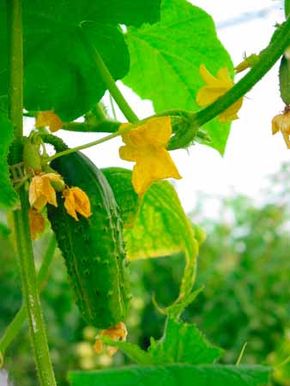A vegetable garden can be the perfect addition to your landscape. Growing your own vegetables organically ensures healthful produce and saves you the high prices of organically grown produce at the grocery store.
When thinking about how to start growing vegetables, the first thing you'll want to look at is seeds and placement.
Advertisement
- Situate your vegetable garden in a sunny place and start growing food early in the spring. Keep planting all summer long so something fresh and tasty is always ready to harvest.
- Place the garden near your kitchen. It will be easy to run out and pick a few things you need, and you can spy on the garden from your window. Picking tomatoes after you see them blush crimson is a perfect way to get them at their best.
- Soak seeds to get a jump on the season. Before germinating, seeds need to drink up moisture, just as if drenched by spring rains. Once they become plump and swollen, the little embryo inside will begin to grow.
Seeds such as broccoli, cabbage, and arugula use moisture efficiently and germinate promptly without pre-soaking. But slower-starting parsley and parsnip seeds benefit from pre-soaking. Dunk the seeds in room-temperature water for several hours or even overnight, but don't forget them and leave them in too long. Drain and plant the seeds immediately.
- Use water-filled tepees around early planted tender vegetables for protection from the cold. You can buy inexpensive plastic sheets of connected tubes that, when filled with water, form self-supporting walls around seedlings. The clear walls allow sun to penetrate to the plant inside while the solar-heated water stays warm into the night.
- Rather than direct sowing, start with large seedlings grown on the windowsill or purchased at a nursery for quick results especially in cold climates. This strategy works well for tender vegetables such as beefsteak tomatoes and chili peppers, which take a long time to ripen but must squeeze in their performance before the last curtain (frost) does them in for the season.
Look for seedlings grown in large pots (check for a strong, well developed root system) with healthy green leaves and a sturdy constitution. Avoid neglected, spindly, or overgrown seedlings.
Note that not every seedling transplants well when older. Cucumbers, squash, zucchini, pumpkins, and ornamental gourds are best started by direct sowing or from young seedlings planted carefully to minimize root disturbance.
- Plant leggy vegetable seedlings deeper (up to the first set of leaves) to provide a stronger start outdoors. Seedlings started indoors or in crowded greenhouses (places without enough light) may develop lanky, barren stems that topple over in the garden. As long as they grow from a single stem (rather than a rosette of leaves) and go into well-drained soil, leggy seedlings can be submerged slightly deep for extra support.
For flexible-stemmed seedlings like tomatoes, a horizontal planting trench is better than a vertical one. It is warmer and better aerated than deeper soil, encouraging good root growth and fast development.
- Keep cutworms away from seedlings with the cardboard centers of toilet paper rolls. Cutworms, which are moth caterpillars, creep along the soil surface, eating tender stem bases of young seedlings and cutting sprouts off at the roots.
After planting, just set a 3-inch-long cardboard tube around the seedling. Push the tube down so half is submerged, thus preventing underground attacks. Then once the seedling has grown into a plant, you can remove the cardboard collar.
- Tear the tops and bottoms off peat pots when setting out vegetables. Peat pots, which are supposed to decay when submerged in the soil, don't always break down the first year they are planted. This leaves plant roots captive inside. To complicate matters further, if the peat rim emerges above the soil surface, it can dry out and steal moisture from the surrounding soil and nearby roots. Peat pot problems are easily solved by tearing off the top and bottom of the pot before planting. This helps eliminate the danger of drying out and gives roots a way to escape if the peat pot persists.
- Plant vertically to save space. Instead of letting beans, cucumbers, melons, and squash sprawl across the ground, you can let them climb a trellis or arbor.
- Add height to a vegetable garden with a tepee covered with bean and pea vines. This space saver works similarly to a trellis but has a different look. Make the tepee of six or eight 6-foot-high poles tied together at the top. Plant pole beans, lima beans, or peas around each pole, and they will twine up to the top.
- Side-dress long-growing crops, such as indeterminate tomatoes, eggplants, and peppers, with a balanced vegetable garden fertilizer to keep them producing. After the first harvest, sprinkle some granular fertilizer around the perimeter of the plants, then work it lightly into the soil and water well. The extra nutrients can encourage blossoming of new flowers and development of fruits afterward.
- Use newspaper covered with straw between garden rows to eliminate weeds and retain moisture. This dynamic duo works more efficiently together than either one alone. At the end of the growing season, rototill the paper and straw into the soil to decay.
- Plant melons and cucumbers in the compost pile. (They might grow there anyway if you toss old fruits on the pile in the fall.) Warm, moist, nutrient-rich compost seems to bring out the best in melon and cucumber vines.
- Extend the fall harvest season for crops such as cabbage, Brussels sprouts, and broccoli with a warm coat of straw. Although it may never be fashionably chic, straw does trap heat effectively.
Advertisement
